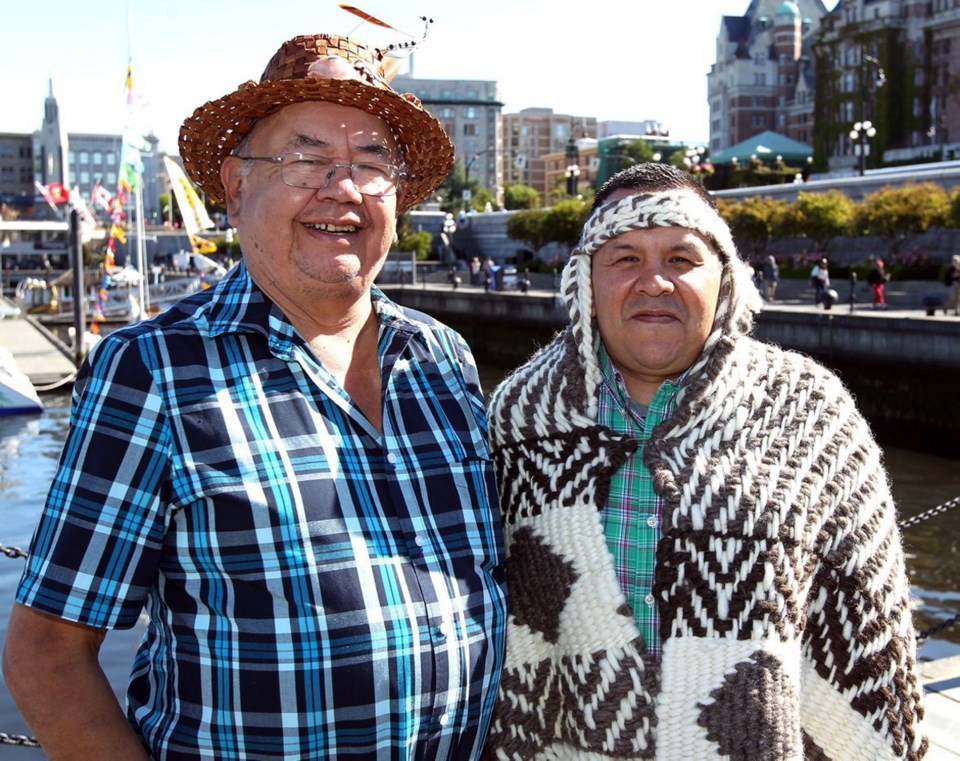Standing far below ground in the grey and understandably grim bowels of the Fairmont Empress hotel, Esquimalt Nation hereditary chief Andy Thomas spreads his arms wide apart.
“This whole area was James Bay,” he said to other dignitaries deep underground with him, including Lt.-Gov. Judith Guichon, Songhees Chief Ron Sam and local mayors taking the ultimate off-the-beaten-track tour.
Before construction of the Empress began more than a century ago, James Bay was a body of water that supported prime clamming grounds for First Nations. A favoured tying-up place for canoes, its mud flats included a tidal estuary for an above-ground stream that, until 1860, took cedar canoes rapidly through what is now Fairfield to Ross Bay and ocean waters. There is no longer a body of water named James Bay.
It was a strange but fitting place to be Sunday for the first meeting in nearly a century between the two hereditary chiefs and the Queen’s representative in B.C., said philanthropist Derek Sanderson, who with his wife, Julie, arranged the meeting on National Aboriginal Day on Sunday.
An elegant breakfast upstairs in the hotel preceded the basement tour that also marked the first time aboriginal representatives had seen the enormous concrete pylons that surround all 2,080 Douglas fir trees driven into the swampy land to support construction.
“You can imagine how high they were,” said hotel general manager Don Fennerty as he warned people to watch their heads while they meandered for the better part of a city block underground.
After the Empress tour, which included the grandeur of the Crystal Ballroom, the local leaders’ outing took in new buildings and dances and drumming on two reserves near Admirals Road before heading to the aboriginal festival outside the Royal B.C. Museum.
It’s the first time Guichon had visited the traditional territories, Sanderson said.
Esquimalt’s new Big House is a community “stronghold” and stands as “our gift to the kids of the future,” Thomas said. He noted that 60 per cent of the band is under age 16. “It’s a good problem to have.”
Built at a cost of about $2 million, it boasts a modern kitchen, huge light-filled dining area and a long house with earthen floor, fire pits and wooden walls.
About 150 people live in about 40 homes on the reserve and some move into the long house in winter.
“It’s a beautiful life we have. Simple is tough sometimes,” Thomas said. Still, he is grateful to be living in a time when “good change” is coming in the relationships between First Nations and the rest of the culture.
Looking out the back window of the centre at what is now federal Department of Defence land, Thomas noted there were very few senior members left in the Esquimalt First Nation in 1911. “The government just about wiped us out,” he said.
At the Songhees reserve, where about 300 people live in 100 houses, the Wellness Centre has pride of place.
“Our whole community is under one roof,” said Sam, citing health, education, band administration and an elders’ room. There’s even children’s programming for early teaching of traditional art techniques and a gym acoustically designed not to echo that can also be transformed into a dining room for 450.
Esquimalt Mayor Barb Desjardins called the centre “an amazing success.”
Sam said discussion and collaboration with non-First Nations is happening more than in the past. Natives and non-natives won’t always agree but instead of taking offence, they need to “find a middle ground and move forward with all the people in this region.”
By the enormous cedar loon sculpture outside the front doors, carver Clarence Dick explained its significance as a symbol of serenity. But because it’s hollowed out on one side, it’s also “the biggest ladle in the world,” he said.
Dick worked on the loon with his father, Butch Dick, and a team of carvers.
Later, in a speech in front of the Royal B.C. Museum honouring First Nations “wisdom, culture and heritage,” Guichon said there has been great change in the 17 years since National Aboriginal Day was first celebrated.
“The process of acknowledging the grave mistakes made in the past has been long and painful, but we are slowly developing an understanding of each other’s cultures and the need to operate from a basis of trust and respect rather than out of fear,” she said. “Only then can we build healthy communities for all our children and grandchildren.”
Massive global challenges such as melting ice caps and millions of refugees on the move will require “the wisdom and expertise” of everyone, especially the experience of elders, she said.
Only three years ago, Oak Bay Mayor Nils Jensen recalled that a First Nations man told him he had never been to Oak Bay before because he did not feel welcome there.
“It was a motivation for us to start building bridges,” Jensen said, adding there will be a First Nations welcoming pole for the new Oak Bay high school.
Elder MaryAnn Thomas said “it’s good to see us all come together because we’re the teachers of the younger generation.”
A survivor of residential schools, she said her head was forced into a toilet bowl for so-called infractions, but she’s taken her father’s advice not to dwell on abuse and to forgive the nun and priest involved. “I’m really grateful to my father for that heart teaching.”



